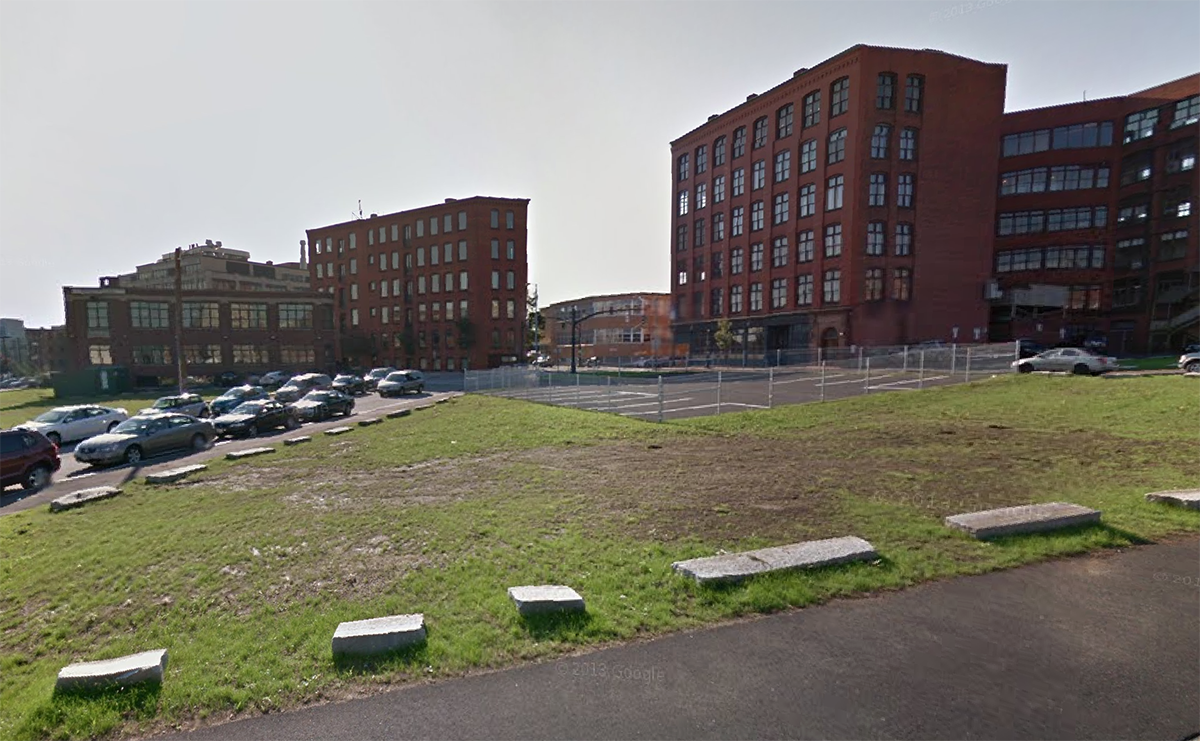
Image from 195 District Parcel 28 – Google Streetview
[box style=”alert”]Updated: January 12, 2015[/alert]The Journal’s Kate Bramson reports from the 195 Commission Meeting that the developer of Parcel 28 has entered into an agreement to buy the nightclubs on the corner of Richmond and Friendship Streets. This will give the developers a full block to develop. It appears the developer plans to tear down the building where the nightclubs are and construct a second building.
Bramson also tweeted this rendering from the presentation.
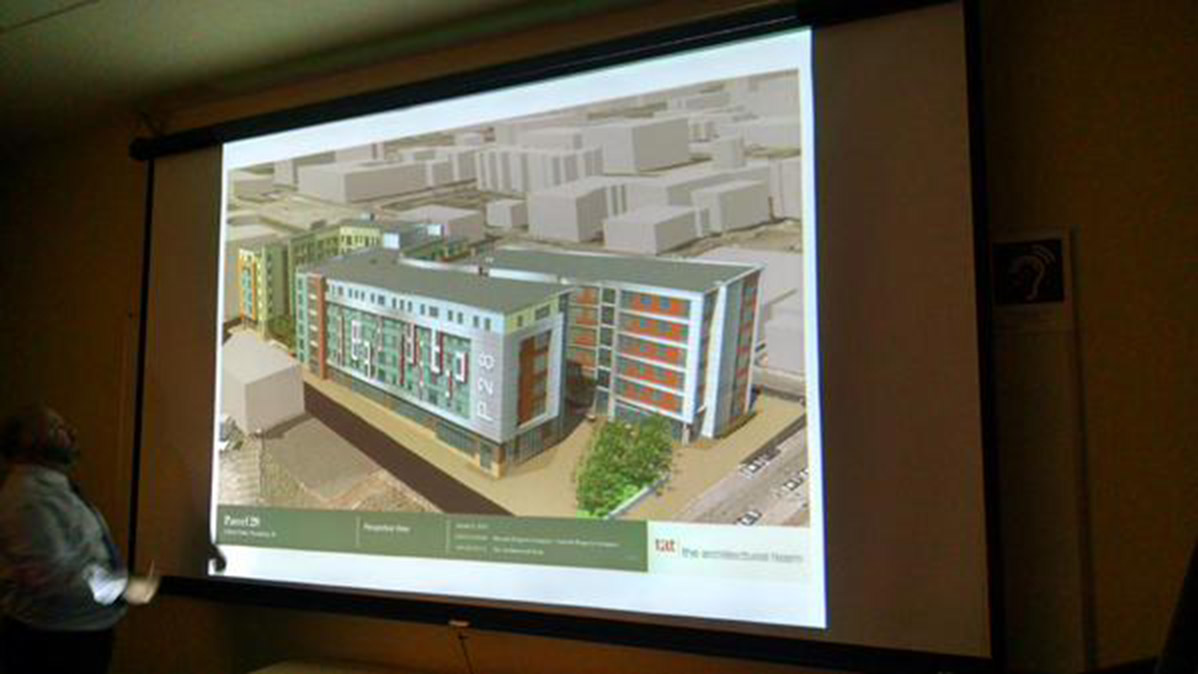
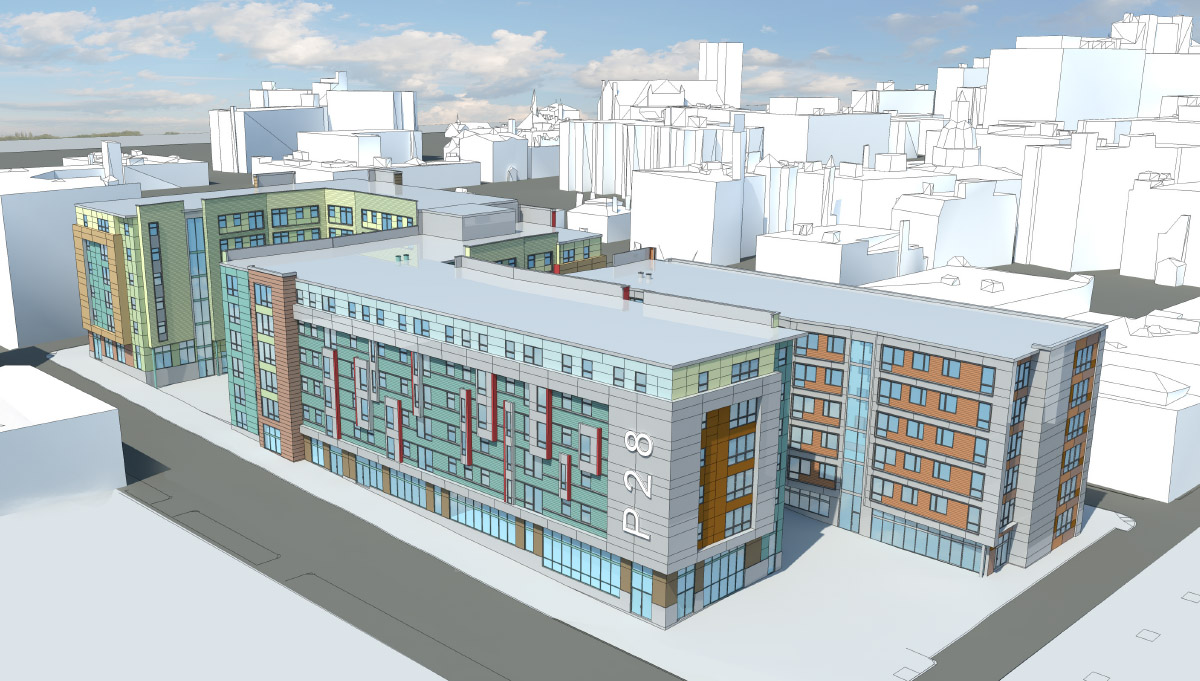
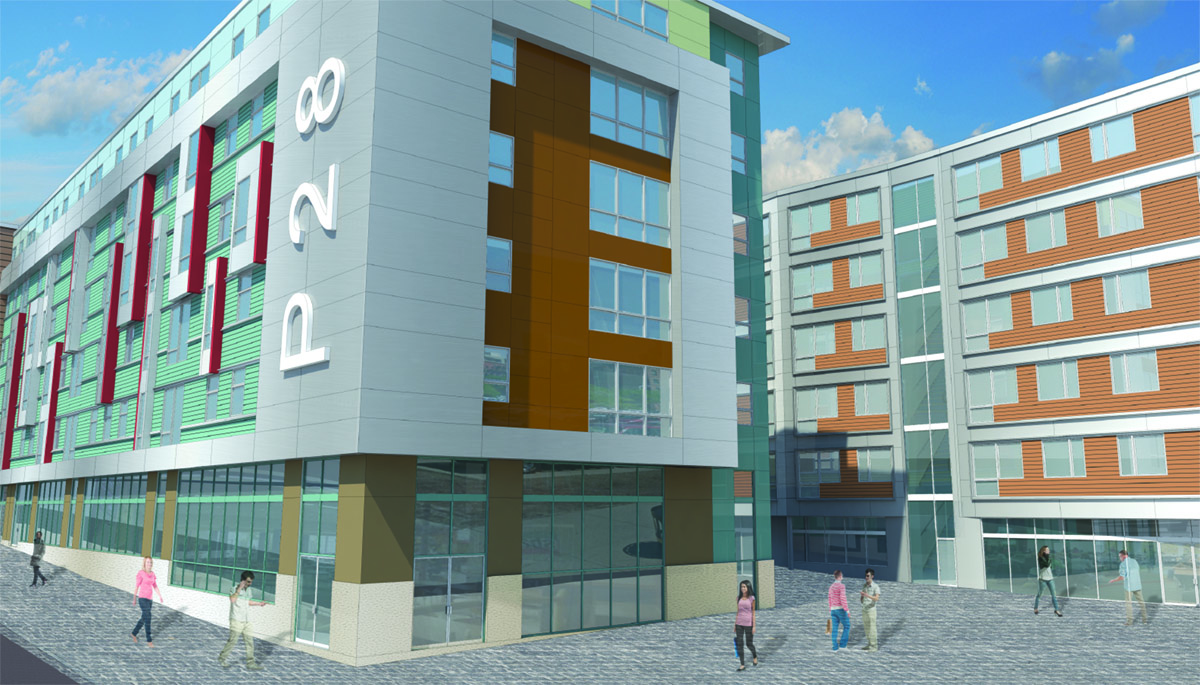
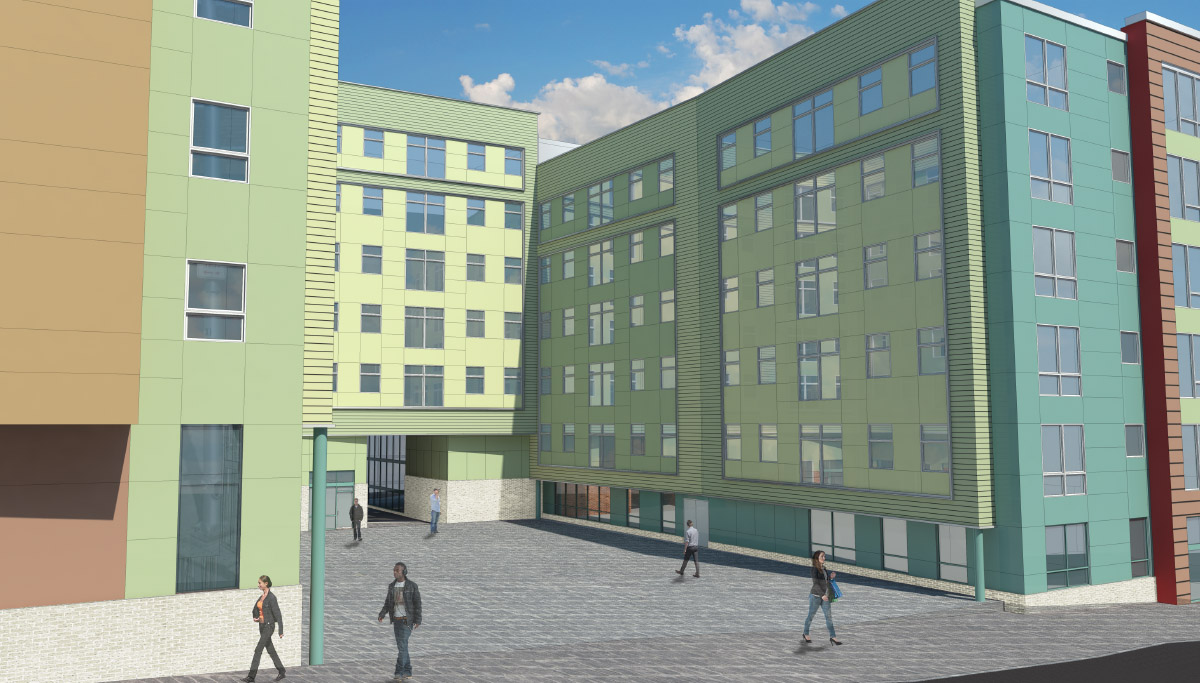
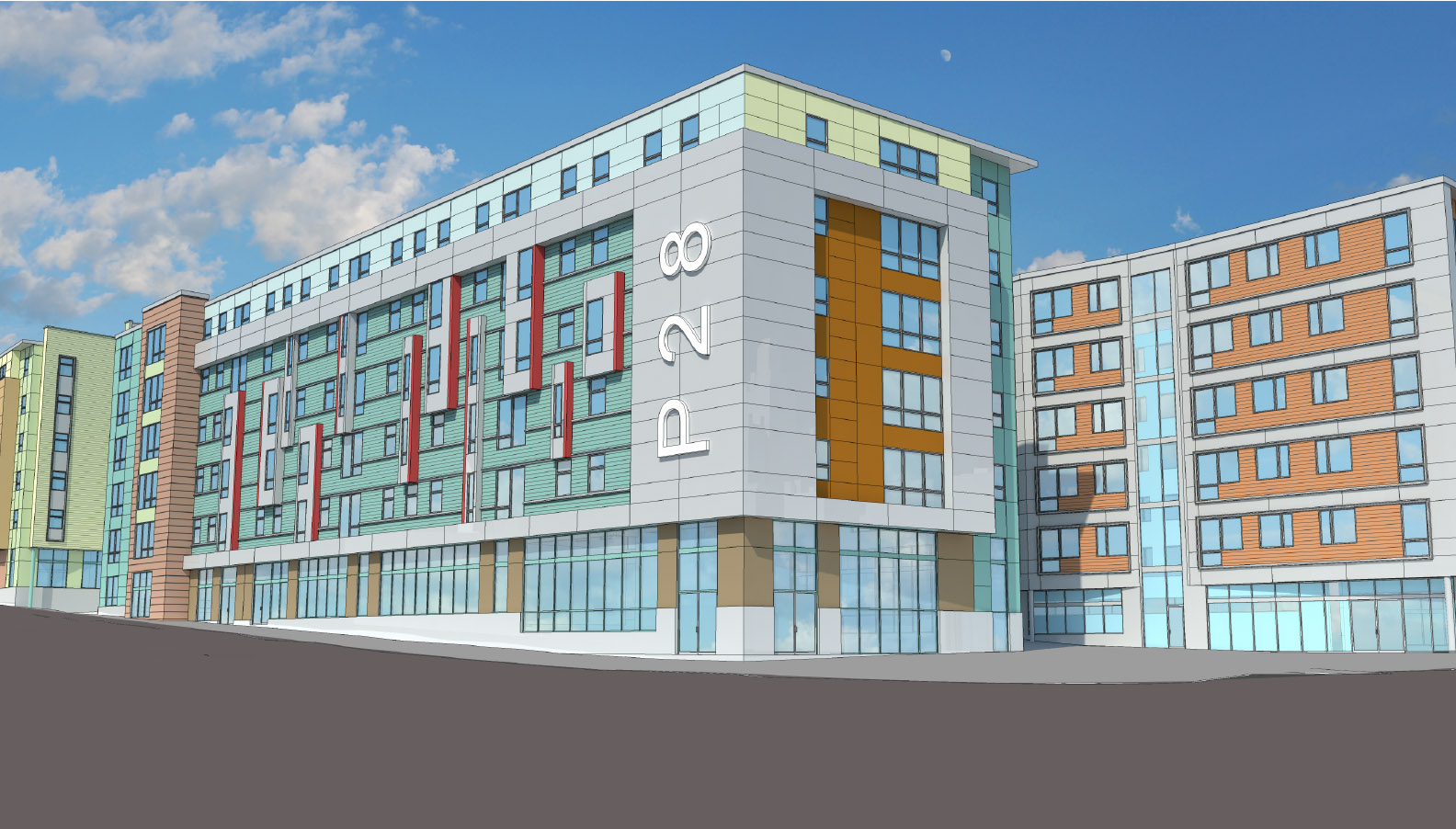
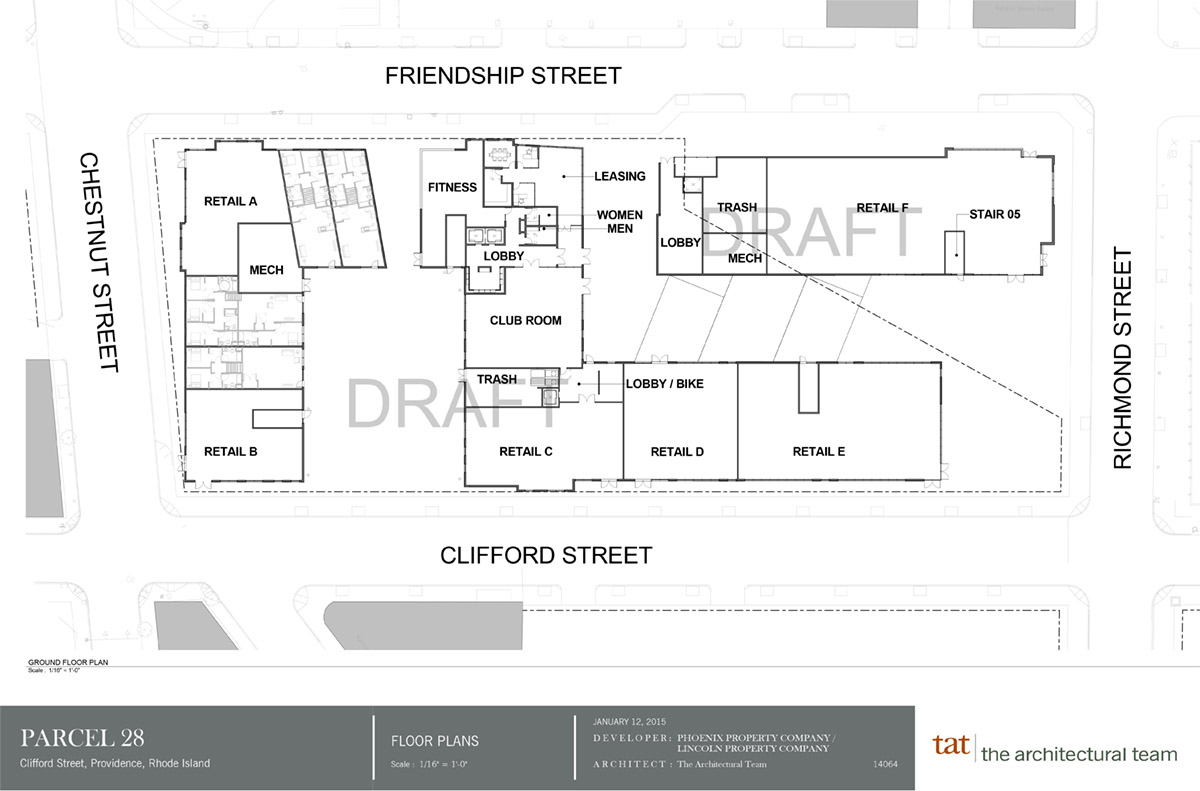

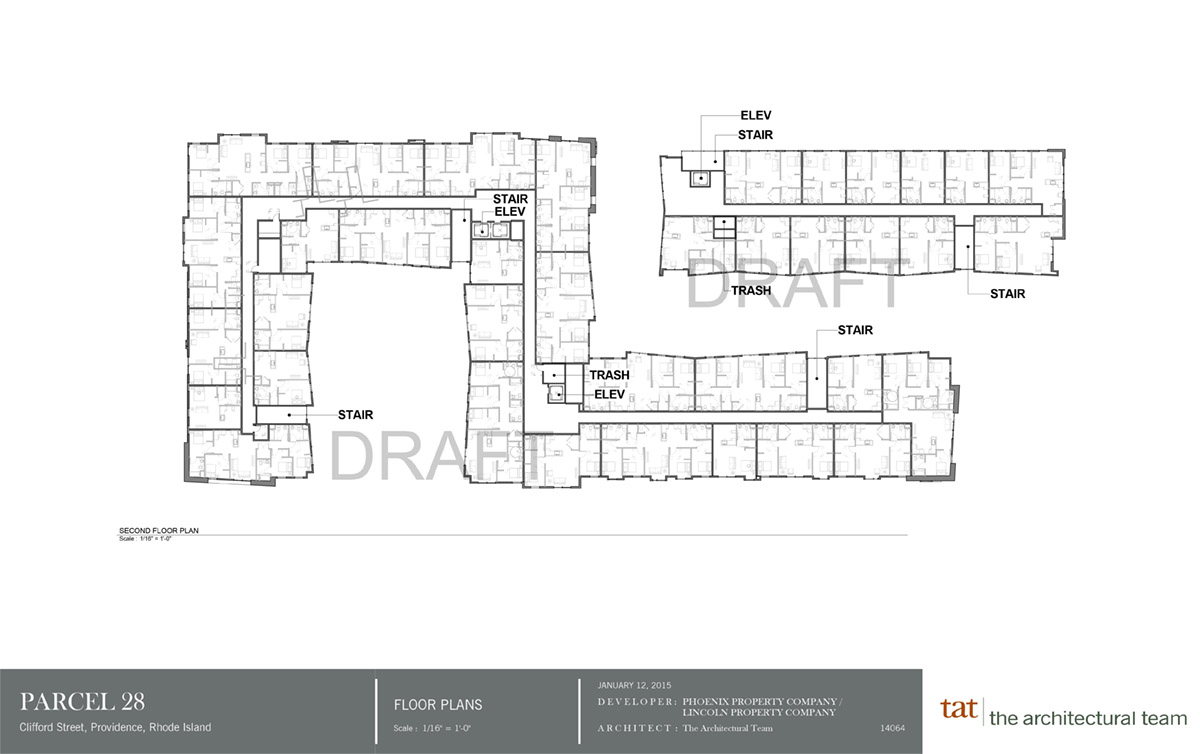
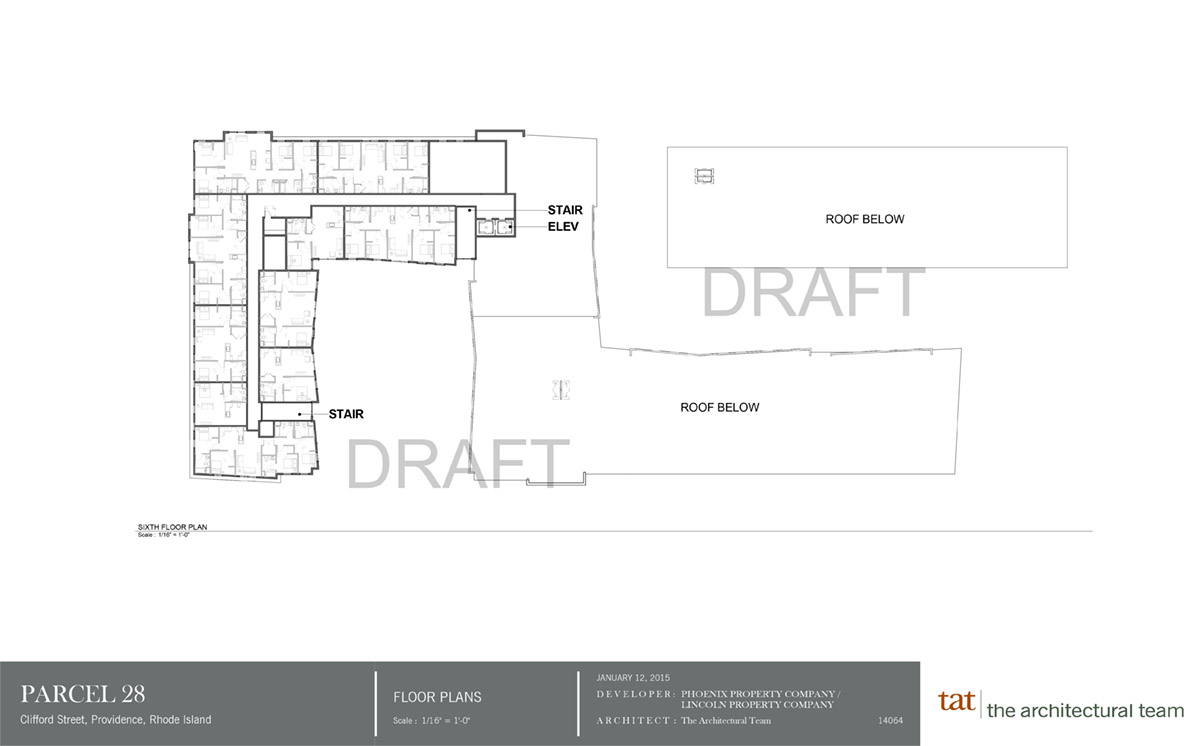
The I-195 Redevelopment District Commission voted behind closed doors Monday to sign a purchase and sale agreement with a Texas development firm that specializes in privatized student housing to build a $50-million, six-story housing development that will accommodate 500 renters on the west side of the Providence River.
Kane said the commission authorized him to sign the purchase and sale agreement, which will be a binding document requiring the firm to break ground by August 2015. Brodie said the firm expects to open its doors Sept. 1, 2017, ready for people to move into its rental units.
First, yes, it is going to be great to get something built on the 195 Land, and work is projected to begin next summer. With 20,000 square feet of retail space, this project should be able to provide some badly needed retail services to the Jewelry District neighborhood. And having 500 units of housing dropped from the sky has the potential to really have a positive impact on the neighborhood.
However, as the commenters at ProJo said, this deal literally took place behind closed doors. However, people involved in development and real estate all seemed to know this deal was coming, it was just the general public that may be surprised to hear about this this morning. So, if the people most involved in the process, pretty much know what is going on through industry chatter, where’s the need for the secrecy? I know there is a degree of discretion needed to complete a real estate deal, but the Commission really needs to do something about the perception that these Executive Sessions send to the public.

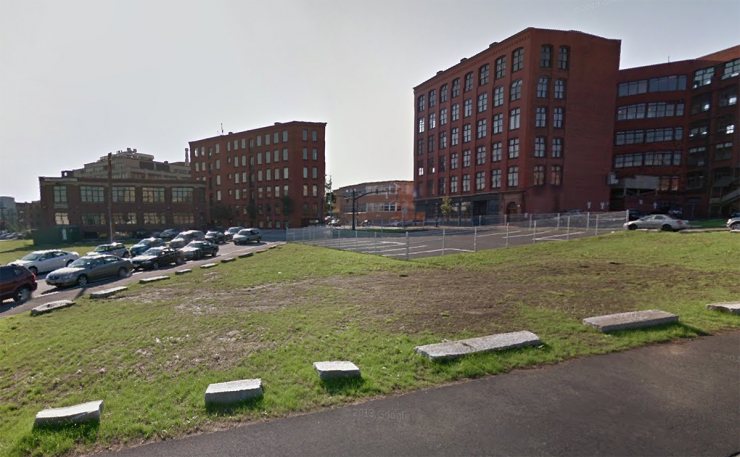
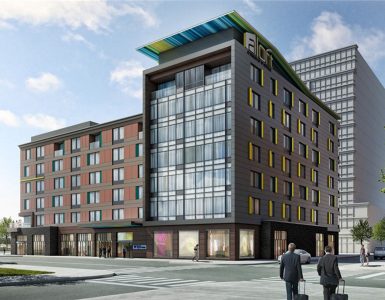
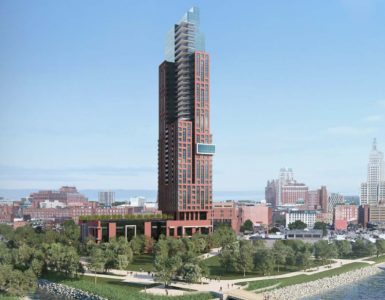
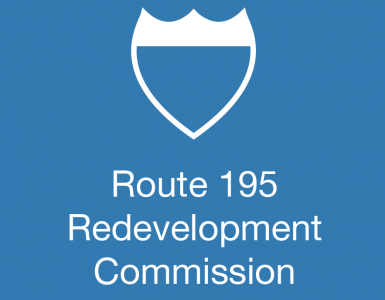

This is great news. However it leads me to another question. The parking lot across the street from this lot (I believe it owned by Jwu): Has there ever been any talk about developing this lot by the University? I believe I heard years ago it was slated for some future campus expansion but haven’t heard a peep since. With the now built parking garage, one would think the spaces being used in this lot are now obsolete since has been built. It would be nice to see this lot developed and stitch together a seamless flow of development from Downcity into the new land.
The retail is great and I’m excited that there is intention to build. However, more student housing is a huge disappointment.
No reasonable, working adult will ever want to live in suite style housing amongst a bunch of 18 and 20 year olds. Providence does not need another Capital Cove.
I am concerned about the secrecy, the lack of height, and the previous denial of the proposed 11 story hotel.
I wonder, though, whether the creation of student housing actually makes neighborhoods better or if it is like the myth of road creation/expansion somehow fixing traffic problems. Does it really take the pressure off neighborhoods in the form of returning affordable housing, or does it simply move some students to new housing and new students take over the old housing?
I dunno, as someone who works in the Jewelry District and spend a lot of time walking & biking in that neighborhood, I’ve got to think that 500 people living there would add incentive for more commercial development. I hope.
The 195 Commission has a little more information about this project on their website.
I’ve got to think that student housing relieves the pressure on more affordable stock in other neighborhoods. I think JWU is very serious about expansion with the PA school and other new buildings going up along Pine Street so it may only reduce the impact of that growth and help to dissuade them from building more dorms that would be off the tax roles entirely and less likely to meet some of the restrictions on hiring local construction etc.
Since there’s a finite number of students (40,000-ish in Providence), whether it’s student or market rate housing, if new housing is constructed in the downtown area, it seems reasonable that it would take pressure off of traditionally more affordable neighborhoods in other parts of the city.
I understand the concerns with this project… but I also cannot ignore the fact that 500 people is 500 people. People love cities because of density and the energy that you feel just being around so many people at one time (among many other reasons), and this will only help the image of the liveliness of Providence.
What is the status of the more affordable Kinsley building redevelopment.. btw?
500 students. 500 students that already exist in Providence. This does not mean 500 new residents in Providence. 18-22 year old out-of-state students who do not pay municipal taxes, who do not make big purchases or investements in the local economy, who are not emotionally, culturally or finically invested in the cities future.
So if some of those 500 are 1 (choosing downtown over the east side) or 2 (new because the colleges are expanding and increasing their student population in general), then it would increase density, liveliness, and support for more businesses downtown. A decent shopping, eating, and entertainment experience will do nothing but help keep graduates here.
Brain drain is not 100% because people cannot find a job here.. maybe they just think the city is dead in their opinion… and it still more often is dead than not.
And considering the universities they are probably attending, they probably have more disposable income than the people who might otherwise be living on that land.
Personally, I am confused on why policymakers and so confused about why they can’t kickstart downtown Providence and make it more of a bustling hub. They cite the colleges/universities as a major asset, but they are forgetting that affordable (and attractive) housing may actually be more important. There are plenty of young professional Rhode Islanders that currently live outside the City that wish to relocate downtown but simply can not afford it. As a resident of the Jewelry District, I know that I searched for a very long time (4-6 months) to find the place I currently live. I love all parts of Providence, but ultimately I decided on an area that is transforming in front of my eyes. I have many colleagues, friends, and family that wish to relocate downtown but they just can’t find a decent place to live with perceived value. The City needs to be identifying a handful of office to apartment conversions, or new projects to nurture and support every single year — not student housing, but actual young, taxpaying professionals that embrace and love Providence. It will all become a self fulfilling prophecy. A healthy stock of affordable housing meets a healthy stock of college graduates supports the relocation and growth of businesses that create jobs and pay taxes. Repeat. On that note, does anyone know why developers aren’t converting all this office space that Providence is DROWNING in to residential units? It really is sickening how much empty office space this City has.
KCB, I am one of those, single-young-30 something-community active-creative-professionals that for years downtown developers and policy makers have been trying to lure downtown. I can hardly afford to live in my dumpy Fox Point apartment let a lone think to even want to relocate downtown where most of my activity and client base is. So I agree with you.
Michael, the only reason developers are continuing to seek the student tenant population is because its the only projected continued source of revenue and occupancy for them. They have a built in tenant for four years or more and rotating out every such cycle. These types of developments are only sustainable for the developer and not the city ecology at large. If it takes students off of the East Side, good luck. However, I can tell you, us young-professional-30 somethings would much rather be living in and adding to a long term vibrant city-core than in a dumpy East Side and over priced apartment. But alas, the jobs do not exist here. The jobs that pay a living wage or more are far and few between – its just how it is.
Furthermore, when warmer months come, most of those 500 students will go – elsewhere. This project is too short-sighted as are most in the downtown redevelopment area. The only good thing is the retail aspect, yet again, the development doesn’t even take advantage of the entire footprint of the parcel and allows for larger than necessary courtyards and plazas. Its a suburbanized-collegiate dorm that would fit better at the Kingston Emporium at URI than in Downtown Providence.
I can only pray that further proposals are better suited for the area and that the long term goals for ALL of Providence’s tax-paying citizens is taken more seriously.
Converting office space to residential units is not all that easy. In most cases adding the additional bathrooms and kitchens (and the associated plumbing chases) to make it residential can be expensive. Once you have a cost per square foot to make the conversion you may find that the rents you have to charge to see a decent return on your investment will be too high for the market to bear.
I am not saying that it can’t be done but a lot developers would rather wait it out for a tenant or take on short term tenants than spend the money and take their building out of service for a year or two for something that won’t generate as much as commercial rents do.
I think to lose that commercial space would be unfortunate as well, unless of course there were high enough demand for residential. It seems to be less expensive to build new? There always needs to be a good balance of industry and residential for a city to thrive. Providence is still on the wire.
Theres been so much focus on residential downtown over the years, we need an equal amount of focus on jobs and filling those commercial vacancies otherwise theres nothing for residents to go to, shop at, work for or live by.
Residential vacancies are very low in providence which is usually a sign that there’s a demand for housing but the problem is the problem is that construction costs are high in Providence. There’s not a lot empty land in providence to develop on and I really think that there shouldn’t be height restrictions or parking minimums at all in Providence. I can understand the correlation between Unemployment and property development. There’s a weird paradigm of high housing demand and high unemployment/high office vacancy in Providence so in retrospect, more and better affordable housing (In the style of transit oriented development/smart growth), more jobs and a better economy will cause developers to develop land in Providence.
Theres actually a ton of developable land in Providence. i.e. The 19 acres that are the former I-195 land we’re talking about not to mention the acres upon acres of surface parking lots throughout downtown and the Jewelry District.
Andy, I was discluding surface parking because surface parking has a usage while undeveloped land does not and more often than not, its easier to develop on empty land than on a surface lot because the person/ entity that owns the surface lot is making money on it while someone who owns undeveloped land usually doesn’t make money off of it unless it’s a private park. I was referring to the entire city. Also the former I-195 land isn’t really a big area if you compare it to the total amount of space in providence, plus there’s a height limit so there’s only a finite amount if density you can fill into those buildings. When you compare the former I-195 land to the size of downtown, it’s a really big land area. If it were easier to develop on surface lots then all those surface lots would be gone. The former I-195 land won’t create the housing supply that is demanded by the high demand for hosing in Providence.
I agree with you to some extent, but thats not exactly why its difficult to build on surface lots. A major barrier to developing those lots is incentive. It essentially costs those land owners more to develop lots just by the current tax code alone than it is to break ground and built upward.
Yes, hight limits and parking minimums do not help the situation, however, correct me if I’m wrong, but I believe the city just this week passed the new zoning structure which should help to elevate some of those restrictions.
I don’t believe there is an over demand for more housing in Providence, but rather a demand for more affordable housing. And that changes not by building more units necessarily, but by providing housing that matches the local working wage and a living wage that is complementary to the standards it takes to living in Providence.
Sure occupancy rates have been up into the 80 percentile and higher over the last few years, but from 2012-2013 there was only a .7% occupancy increase out of some 4,500 residents living in the downtown area – which is approximately 31 people. Not exactly a migration.
Alleviate, though I suppose elevate is appropriate in this context as well 😉
My understanding is that occupancy rates for downtown have continued to be 97-98% for the last five or six years with some buildings at a100%. Is the 80% occupancy the city wide rate?
Downcity occupancy has frequently been cited in the 97+% range so I can only imagine that’s a city wide rate.
The height restrictions are basically a non-issue in Downcity with some areas along the highway zoned well beyond what we’re likely to see built and I think up to 6 or 8 stories throughout the JD being allowed (which is higher than virtually all existing properties except those abutting KP).
Surface lots have not been an acceptable use for property without variances for several years Downcity. There are no parking minimums in Downcity in the new zoning (as well as along other TOD corridors, IIRC such as along the R-line).
Besides, I think this is very prejudicial:
> who do not pay municipal taxes, who do not make big purchases or investements in the local economy, who are not emotionally, culturally or finically invested in the cities future.
This is private housing. It will eventually be on municipal tax roles. Their employees pay taxes. These students shop and spend their money here. Not emotionally invested? Going to college in a place is a huge emotional investment. I came her for college and stayed. Many of my friends did. Friends who didn’t come back and visit often even though most had never stepped foot inside the state of Rhode Island before coming for school. This sort of hate toward students is so overblown in Providence.
And Andy, it’s not true that developers are only building student housing. Kinsey and Lapham are both being developed for “permanent residents” as was the Providence G. I think what you’re lamenting is the difficulty of creating housing that’s priced like the Arcade but sized like the East Side. I don’t think that’s going away any time soon. Newer housing stock is always more expensive than older and I don’t think the economics work out for say, $15 per sq ft rentals.
Back of the envelop:
An 800 sqft condo in a nice building goes for ~$200,000 in Downcity.
At $36 per $1000 of value commercial tax rate you’re looking at $600 in taxes per month alone. Now lets say some of those numbers are fudged way high. I am doubtful that even at $500 a month in taxes per unit that you can get 800-1000 sqft to rent at <$1000 per month.
It would take a fast, massive increase in supply to lower the value of the units low enough, before tax stabilization, so that the taxes alone made it financially feasible. Then factor in the high costs of construction…
Affordable housing, say geared toward earners say at the 30th to 60th percentile of earnings for the city, is not the future for Downcity. It likely never will be. Adding to the supply Downcity likely keeps the prices flat for a long way as it continues to meet pent up demand. That's a great outcome for Providence because we add lots of valuable property that pays taxes into the city coffers, liven up the retail environment in Downcity so it's viable for street level commercial activity, and lowers the pressure on swiftly gentrifying neighborhoods that are pricing lots of folks out because there isn't enough stock Downcity.
Now, you may think I'm out here being cold and not caring about folks who can't afford homes. I think that's bullshit. I'm for growing Providence's population, growing it through infill, improving the revenue situation in the city so we can reinvest heavily and broadly, and decreasing the cost of housing for everyone. I just don't fundamentally believe in the concept of generating set aside housing units in a city that has so much underutilized land. That's a second or third order problem that may not even exist if we build a lot more market rate housing.
I don't really see how six stories is a lack of height. That's very much in line with the existing form from Weybosset and south of there. If we filled in the whole area with 6 story buildings that would be amazing.
I say bravo to just about any construction that leads to residents. I hope we see more that's geared toward the broader residential market, but with the new PA school, URI/RIC nursing (which is getting some housing built as well by South Street Power Station), and plans to expand the B-school and move the tech school into that neighborhood, I wouldn't be surprised if this housing isn't absorbing an actual increase in student population Downcity.
I firmly believe that the goal for Downcity development should be 20,000 residents in 20 years. It doubled from roughly 2,500 to 5,000 from 2000 to 2010. It should double again each decade for the next two. If we succeeded in that, though just about any pathway, it would be hard to look back and see anything but a smashing success for the city.
Here’s the thing though, all y’all up thread said that it would “seem” that more housing for students would mean a return of affordable housing to neighborhoods so regular (non students) could still afford to live places like Fox Point, and Federal Hill, etc. However, is that documented somewhere? Are there studies that support this–I honestly don’t know.
Until I moved to VA in 2008 I had lived in Providence since 1984–first as a student at RI College, then an off campus student (living in Mt Pleasant) and then as an employee at Brown etc, and never have I seen rents that were taken over by students revert back to anything remotely affordable for working class residents of Providence, meanwhile there were more dorms built for JW (downtown, even) and Brown and PC (maybe RISD too?) So I’m just wondering if more student housing relaxes the demand in traditional neighborhoods or not? And I don’t think we’re talking about a static number of students. Not if there’s a new nursing school coming on line, among others.
Yes, students are a valuable commodity in PVD. They spend money, sometimes they even stay after graduation and buy houses and build businesses. They also piss off neighbors, sometimes can be crime-magnets, have loud parties and GET OFF MY LAWN.
Time and time again this forum and its members have banged the drum on how more roads do not fix transit problems, so along those same lines, how does more student housing fix the affordability problem? And I’m not even talking about subsidized housing, I’m just talking about working class housing for people who are making the median or even exceeding income for the area.
When perusing the rents available via craigslist, I was shocked to find that I pay less for a mortgage on a 4 bedroom, 2.5 bath single family home in the wealthiest part of the country (granted, outside the beltway,) than a 2 bedroom rent in a pretty good (not great) neighborhood in Providence. Considering that there’s no way I’d be able to bring my Northern Virginia Salary with me to a similar job in RI–I’d be lucky to be making half of what I make here–luring people like me back is going to be a problem if we can’t afford the rent!
Your mileage, of course, may vary.
When new student housing is built in the downtown core or on a campus, it should limit the expansion of students moving into the neighborhoods. This won’t necessarily lower rents, but it should increase the vacancy rate in the neighborhoods, making apartments available for working people. More importantly limiting the influx of students and increasing vacancy rates should slow down the gentrification process.
Concentrating students in larger projects, such as the current proposal; or the Thayer Street project; or RISD’s Hospital Trust conversion; or RIC’s recent dorm construction in Manton, which increased the Manton neighborhood’s population by roughly 4,000 in the last census, should contribute to reducing the bad student neighbor issue for those who live in 2- or 3-deckers or single-family houses. Having a higher overall vacancy rate citywide will keep rents flat or lessen increases and combined with new market-rate construction, along with time should lower rents.
I still question the 80% occupancy rate. Rents should not have gone up that much in the last couple of years, if 1 in 5 apartments were vacant. BTW the occupancy rate and rents are considerably higher on Aquidneck Island than they are in the Providence area’s urban core. You can still rent a 2-bedroom in Providence or Pawtucket in the $750 to $850 range. For a 2-bedroom in Newport rents jump to $1,000 to $1,300 and usually Newport apartments are smaller.
The thought of multiplying the number of residents Downcity is very exciting..
A 2-bedroom dump along Camp Street or in Elmwood for $750, maybe. The last STUDIO I lived in in Providence from 2010-12 was 450 sq. at $795 and going up to $875 – and that was best ‘deal’ on the market I could find. But I digress.
—
Jason said a whole lot up there, so I’ll simply defer to jen coleslaw’s comment as my answer since she just about summed everything up nicely for me already.
Not meant to deny your experience Andy, but I had a one bedroom on Angell and Thayer for $750 including utilities from 2007-2009 and a 1000sqft 1BR on Power and Benefit for $900 including utilities from 2009-2011. Both had parking. In those neighborhoods at the time, 2br were regularly available for 1000-1500 depending on condition. Wide range but I think prices you cite suggests a far more expensive market than what graduate students at Brown regularly participate in.
I agree with Peter’s description of the mechanism I believe is at play. Regardless, I don’t think anyone should be expecting new construction in I195 land that is producing “affordable” units directly. That’s probably ok and also doesn’t stop that construction from making a healthier, more affordable housing market at the ecosystem level than would exist without these developments.
Yeah . . .$750 to $850 and not just on Camp Street or Elmwood Avenue, but even Federal Hill or the Armory or Oak Hill, occasionally Fox Point or Elmhurst or Edgewood and they’re not all dumps.
Affordable housing doesn’t equal luxury housing and shouldn’t. At $200- $300 a square foot construction and acquisition costs, are developers suppose to build new affordable housing in trendy neighborhoods with established cafes, bars, and boutiques for the special few who come from higher social or economic circumstances?
A neighborhood is what you make of it. If one happens to be young and not yet financially established, who comes from a more advantaged background, just by showing up and moving into a perceived less desirable neighborhood—you change it. The truly disadvantages, who have grown poor neighborhoods who may not have had the opportunity to attend college are no less deserving of affordable housing.
There may be poverty and crime issues in less desirable neighborhoods, but it’s never everywhere in those neighborhoods. There are always decent sections and they are usually at the edges.
Since this site discusses city issues, the focus of this piece and many besides housing has been on attracting or retaining the more advantaged, which is a completely valid topic. On the flip side, part of this discussion should include, how do we contribute to assist our fellow city residents from less advantaged backgrounds improve their circumstances, neighborhoods, and the city that everyone shares?
I agree, and I’m not saying what downtown needs is public housing testaments. What I’m saying is that I hope the I-195 land isn’t devote to creating a singular eco-system of student-centric facilities or this so-called “knowledge district” (which has its own segregated ick sounding factor).
For any modern city to survive, there needs to be room for all levels of its citizens to participate including diverse opportunities for places to live and work – including downtown.
Right now, rents are too high and jobs too few for the average Providence resident. I’m in-line with the Thayer St. project and perhaps I need to re-evaluate this one if what we’re trying to create is density and bring down market prices. However, I’d like to see a mix of residential units in this district, if not for the economics, for the psychology of a city knowing its well positioned for the future.
PS. Can I borrow your real-estate agent?
I think rents on studios in Providence are actually artificially high, our housing stock doesn’t really provide very many studio apartments. Some studios come about because the layout of the space does not allow for a bedroom to actually be enclosed, resulting in a one-bed sized unit that is technically a studio due to an odd configuration of windows, etc.
I had a 4-bedroom apartment on Federal Hill for $975 two years ago (granted, it had a microscopic kitchen). Given how small our city is, it was basically downtown. If the highway wasn’t there, we’d all consider Atwells to be a downtown neighborhood.
The rents along Broadway are stupid expensive south of Broadway, but north of Broadway they are way more sensical. Living on the “West Side” vs. “Federal Hill” changes rents drastically. Sheeple are willing to pay an extra $200 to live 2 blocks south of Seven Stars rather than 2 blocks north of it.
ProJo: Developer paid more than twice original offer for 195 land
And now the ProJo is having to make requests for information to the Commission. The requests seem to be being granted, but the lack of transparency continues to be troubling.
ProJo: 195 deal hinges on tax break
So the city has to give the developer a tax break, but has little say in the project (or really any projects for this land, most of which will likely want tax breaks)?
That’s exactly why people were against the I-195 Commission’s formation in the first place. It was designed to ensure that the state determines the uses while the city still has to do TSAs.
However, they do have to at least follow the 2012 zoning for Downcity.
I find it hard to believe that Paolino types can’t convert some office space that they own downtown to basic, small studio style spaces and make money doing so. Installing a bathroom and a kitchen sink on a shared wall, three plumbing connections, is not difficult nor expensive. I have viewed some of these building styles and some already have bathrooms. The market rate for these type of studio units would be cheaper than the new units by the Train Station (which are pretty overpriced, in my opinion, but people will pay for convenience and accessibility — these are $1,900 for a 700 square foot 1BR/1BA), $1,200/$1,300 per month for these small studios downtown maybe? Who cares if they are super small, they are downtown. A young working couple in RI can afford $150/each per week for housing. There is a huge different between paying $1,200 and $1,900 per month, $1,200 appeals to such a larger income bracket for Providence. Residential units like the Providence G do absolutely nothing to improve the cultural fabric of Providence (or solve the affordable housing issue) — they are actually asking $2,900 per month for some of their units, who are they appealing to? It’s not shocking that nearly a year after people moved in, they still aren’t fully occupied. So let’s just look at these type of projects as appealing to corporate housing clients, or the (in)dependently wealthy — these projects just don’t match the RI demographics. It seems like there is a real barbell of potential projects in RI… student housing (disconnected from the traditional property market, and recession free) and very expensive “luxury” apartments. Nothing in between, except for the Arcade; which if there were stoves in the Arcade units, this model should be duplicated over and over until demand downtown shows signs of sluggish growth. I live downtown and I’m a believer that if affordable downtown housing stock appeared, it would be filled very quickly.
I’m just making numbers up for the sake of it, which is troublesome of course, but 6-10 of these small studio spaces per floor (times 3 or 4 floors) is a lot more rental income than Paolino’s empty commercial space is generating, and in this economy… competitively priced month to month residential rental agreements for prime downcity apartments are safer income than commercial space for non-existent companies. These would be fully occupied and would never hit the open market. The size of the space needs to match the price of course, but by locating smaller sized units in a downtown core, can’t a landlord get away with smaller spaces and a higher cost per square foot? The solution should be in the design.
Providence should adopt some kind of policy to suggestively push landlords, slumlords, gluttons, whatever type of property owner they are, to set a real (competitive) market rate for their housing or commercial space. I have spoken to many business owners that have looked to expand a retail presence downtown (businesses were a diner, jewelry store, art studio, and boutique shop for clothing), and they have shopped around to see what space is available. It’s the same thing, over and over again. They tell me about how much Paolino overprices his spaces. Landlords are keeping downtown from really showing progress, at least the organic/”indie” progress that small businesses bring to a city neighborhood. There should be a vacancy tax of some sort. Empty spaces increase crime, vandalism, loitering, etc., why shouldn’t empty buildings be forced to pay for some of the additional police patroling, if its not needed completely, roll the funds into community development projects. Paolino types shouldn’t be able to price their space so high that they remain perpetually empty, without this being addressed as a public/community concern. By increasing the cost to carry empty space, landlords will be forced to lower their rents to bring in new prospective tenants. Eventually, you will get to a real market rate.
I sort of touched upon two or three issues here (at least), apologize for that, but I see them as interconnected and having importance to the progress of our city.
I’m sort of bummed to see more clubs go, but it’s nothing really spectacular that’s going. I’m happy that this project is happening, but we’ve lost so many clubs and venues during the city’s recent growth, that I really hope this is the last of it.
ProJo: Student-housing project in Providence could expand on former I-195 land
PBN: Proposed student apartment project for former I-195 land in Providence grows bigger
PBN: I-195 commission extends time for developer to make deal with city
http://www.providencejournal.com/article/20151110/NEWS/151119937/-1/breaking_ajax
This is great news. This area in front of Karma is terrible at night. Hopefully by locating JWU assets on this corner and more actively patrolling, it will clean it up. It will be safer to walk through that area to get to the other things that are popping up in the neighborhood. I have found that the parking lot across the street from Karma is a magnet for people coming into the city to drink and smoke in their cars before going to the club. It is littered with broken bottles and other garbage after Thurs-Sat nights… Thursdays are commonly the worst in the warm weather months, I’ve seen many instances where women walking through the area are cat called and harassed by people hanging in their cars in that parking lot. Hopefully this puts a stop to that.
Also, is that new Courthouse parking garage going across the street? Will that courthouse have street level retail?